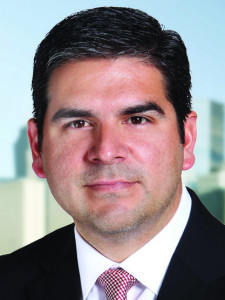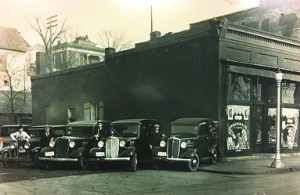
In 1929, Arch and Lourine Wease opened a distribution business based in DeSoto, MO, about 50 miles south of St. Louis. It was not an auspicious year. On October 29, the stock market crashed, triggering a plunge into a 10-year global economic depression. But A. E. Wease Distributors survived and thrived.
Today, if you stop to pick up a pack of gum or a candy bar, or even a platter of Champ’s Chicken at a convenience store in Missouri or Illinois, there is a good chance it came from an A.E. Wease warehouse via an A.E. Wease truck. The business the Weases founded has remained in the family under the leadership of President and CEO Alan Clark and his son, Vice President Bud Clark. Wease has expanded into food service, providing chicken, pizza and other items to meet the needs of a changing consumer base.
But even the best-run companies bump into issues beyond their control, and eventually Wease found itself in a situation that forced it to change lenders.
“About two years ago we lost a major account. They were purchased by someone else,” recalls Charles Tandy, the company’s controller. The acquiring company already owned a distribution system and no longer needed Wease’s services.
“And when we lost the business, our existing lender just was kind of nervous, and they wanted out of the deal because of the lost business. We did everything we could do to remedy their issues or concerns. Whatever we did wasn’t enough.”
Finding a Lender Quickly
Tandy adds the lender was a large bank based in the Midwest, and he has no bad feelings about the business decision it was compelled to make. But because of the nature of the distribution business, Wease had to find another lender quickly.
The company hired a broker and several lenders were considered. In the end, White Oak Commercial Finance became the company’s new lender and provided a $8 million line of credit.
“The consultant was able to provide us with several banking options, and one of them was White Oak. There were a couple of lesser-known commercial banks in the mix. I think there were essentially four that were considered. It’s like anything else. There are strengths and weaknesses for all those lenders, at least in my eyes. Also, this is a privately held company so, obviously, the ownership has a lot to be concerned about in the banking change,” Tandy says.
Tandy says the company put all the information into a spreadsheet to make an evaluation. “We compared all the loan limits, the advance rates and all the details that you look at — the covenants and all the legal criteria, all the affirmative covenants that you had to have and the whole scope of things. And it turned out after meeting with everybody that White Oak seemed to be our best fit.”
For both the team at Wease and David Montiel, head of ABL originations at White Oak Commercial Finance, the meeting part was critical.
Getting a Comfort Level
“We took the time to visit with the company and met with the owners,” Montiel says. “A gentleman and his son run the business. And they have a very capable CFO helping on the finance side. So, we got to a comfort level with the management team and the ownership team. We saw a profitable company serving very loyal customers. They have over 250 customers. They serve an area of the country that is underserved — rural Missouri and Southwest Illinois. And this company provides good service in that area.”
Based on that information, White Oak was able to give Wease the flexibility it needed to recover.
“We also gave them a bit of an equipment line because we felt that they needed to expand their cold storage, which will allow them to save money in other areas,” Montiel adds. “We actually gave them a little bit of ground to expand that capacity.”
Pete McCaffrey, Wease’s operations manager, was impressed with the process and his interactions with the White Oak managers.
“Having met Joe [Silipigni] and Carlos [Acedo] and their team over at White Oak, the one thing that really stuck out in my mind after meeting them even for the first time and spending a couple of days with them was they take the time to know what your daily struggles are. They ask these types of questions, and they have an interest in what is going on and what your process is and try to grow the business,” McCaffrey says.
As a suggestion to other companies looking for a new lender, he emphasizes the importance of open communication.

Keeping Communication Open
“We try to keep them up to date with as much good news as we can provide them with so they know that we’re keeping on track,” he says. “We laid out a plan for them as to how we’re going to try to grow this business. And we constantly update them. They ask for feedback. Sometimes they even throw in a suggestion if they feel it’s appropriate. They care about our business, and it’s very sincere and a very honest, open relationship. Despite what business you’re in, you need to have that type of open communication and transparency in order for you to work together as customer and client.”
The company had been the larger bank’s customer for about five years, and when evaluating a change, Tandy says it was important for Wease to have a lender willing to work with the highs and lows that accompany the distribution business.
“You’ve got to have a bank or a funding arrangement that works for your current situation,” he says. “Things change. Accounts are gained. Accounts are lost. Business is good. Businesses are bad. You have to have somebody willing to deal with the ups and downs.
“I’m not so sure the bigger banks are as willing to do that. They’re a little more by the book. Our prior bank was publicly held, and they probably didn’t have that flexibility.”
More than two years after losing that critical customer, both Tandy and McCaffrey feel secure that Wease is back in fighting form.
“We’ve had some nice super major victories and a lot of nice little victories along the way the last six months or so. Things are definitely improving, and they’ve [White Oak] done a good job for us. Carlos and Joe are great guys to work with, and things are all fine,” McCaffrey says.
Expanding Food Service
He adds the food service business is expanding. With the financing from White Oak, the company rebuilt its freezer facility this past winter to accommodate the growth in that area.
Tandy is happy things are rolling along smoothly, and he has the financing he needs to get through the day. “I guess I’ve been in the ABL lending business for more than 20 years, and I can tell you that the other places I’ve worked, the advances were usually made the day before payroll. That’s not the way we do it here. We have to have large sums of money every day.
“We borrow large sums. We borrow more some days than other people borrow in a month. So, we’ve got to have a process down to get that done. The collateral reporting has to be agreed on. It has to be right. And we’ve put those processes in place. And things just work very well, very quickly. No muss, no fuss.”
Another advantage of working with White Oak, he notes, is White Oak can be nimble; if he needs to make a quick decision, he doesn’t have to wait for a bank committee to meet and discuss it — White Oak can respond quickly.
And it may have to. Tandy notes the $8 million line of credit is good for now, but with business picking up, “in a few months, I would like to see it grow.”
